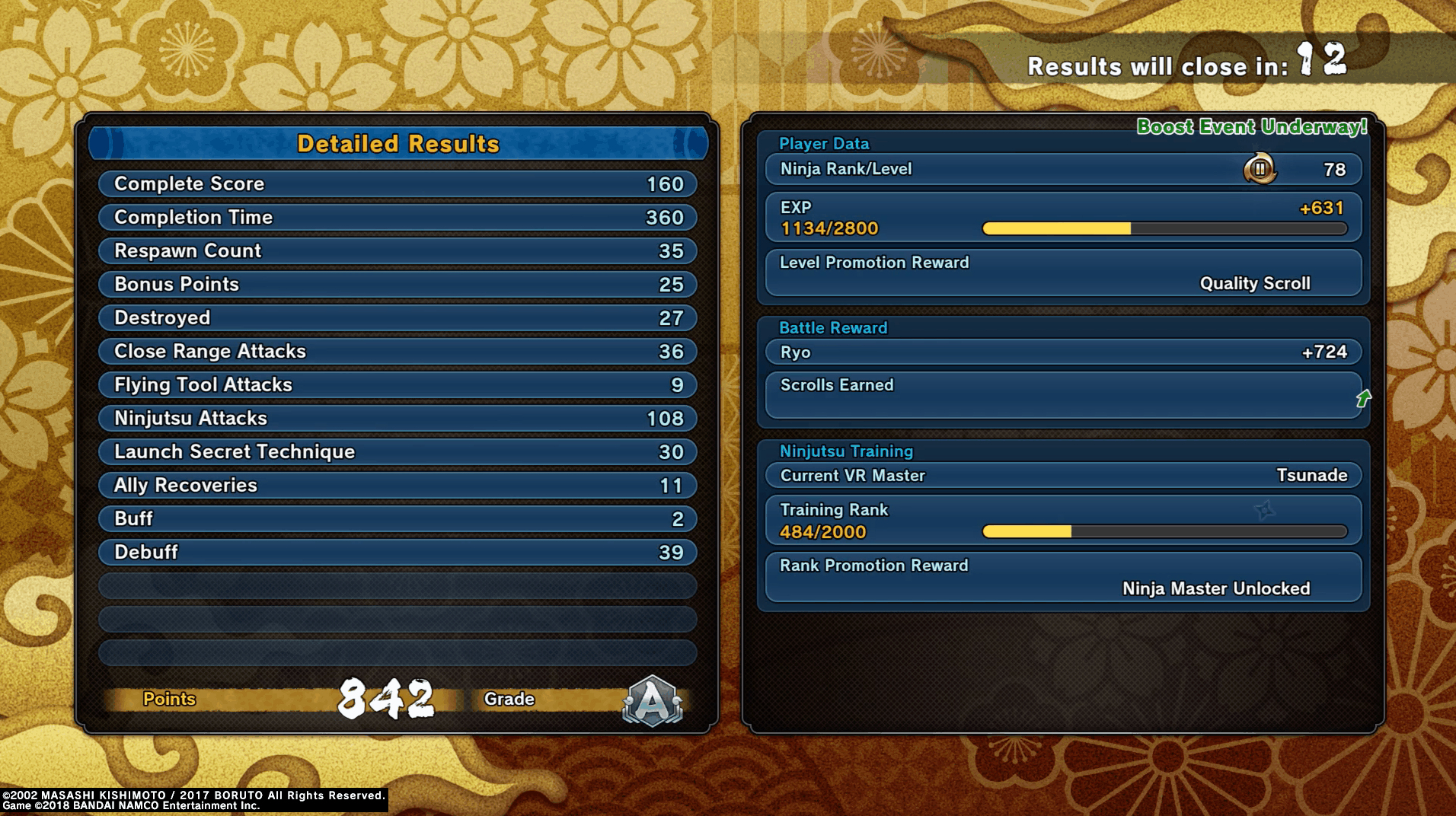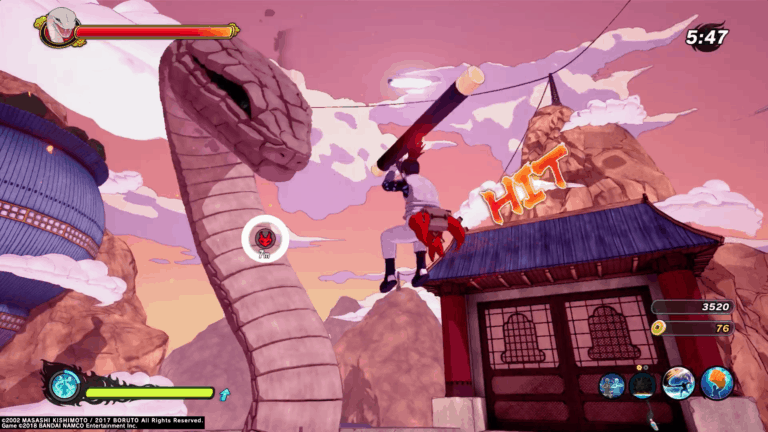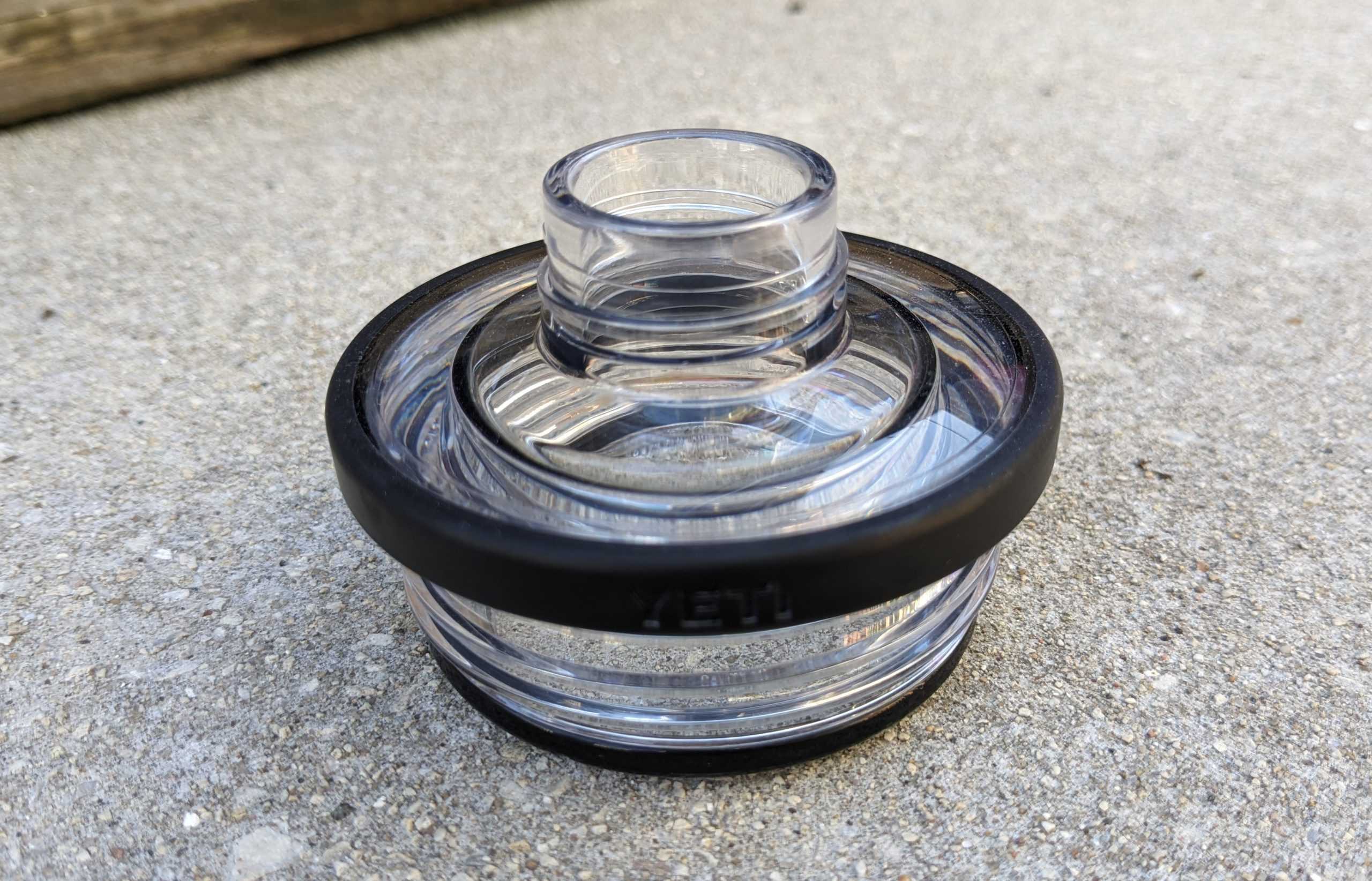In Naruto to Boruto: Shinobi Striker, teams of four fight to the death or in missions involving the manga’s villains, heroes, and lovable tailed beasts. Ninjas jump and dodge through the air across sandy cliffs and cloud-drenched towers. They unleash fireballs, lightning attacks, and devastating special ninjutsu skills in conjunction with triangle-square weapon combos. The game animates beautifully and has some of the best combat we’ve tried, but PvP matchmaking issues and the modest quantity of PvE content made us quit before we dug deep into the intricacies that Shinobi Striker’scombat has to offer.
FLUID MOVEMENT AND COMBAT MECHANICS REQUIRE ARTICULATE, AWARE PLAY
Movement in Shinobi Striker is a thing of beauty. You stick to walls, climbing vertically or even upside-down along eaves and awnings. Using kunai, you grab hold of nearby surfaces and prevent falls. A “chakra jump” is an enormous leap that will carry you across rooftops and the entire map in less time than it takes to tie your shoes. Gravity exists in Shinobi Striker, so movement and aerial combat feels more intuitive than the flabby 3-axis flying in the Dragonball Xenoverse franchise, where your toon always feels a little out of control.
Keeping yourself from being ledged is the first order of business. Taking part in a mid-air battle with the heavens yawning below, ready to swallow your ninja after the slightest button or judgment error, is the higher calling of the game’s movement mechanics. Killing other players in Shinobi Striker can resemble a game of cat and mouse—movement and timing mistakes can have disastrous results, while watching, waiting, and pouncing can lead to easy kills.
On top of movement mechanics, combat requires an even finer level of control and discernment. In each moment of a fight, there are about twenty potential actions your toon can take. Shinobi Strikerincludes active lock-on targeting as well as passive-targeting circles around enemies. Defense mechanics are classics—block and dodge—as well as “substitution,” an unusual mechanic that swaps your ninja with a clone or block of wood in the middle of taking damage.
For offense, players choose a type of “ninja tool” such as shuriken; a weapon from swords to folding Japanese fans; and two skills and one ultimate out of hundreds ranging from heals to summoned killer ghosts. Each weapon has a unique heavy attack and combo/move set that requires practice and experimentation. Skills and ultimates have varying cooldowns, cast speeds, ranges, and logistics including super armor, invincibility frames, and the ability to break an opponent’s guard or counter other skills.
In this game, you’re either dishing out an insane amount of damage or taking it in. Gear doesn’t affect much—neither does character level or chosen skills. A skilled Shinobi Striker player has mastered his weapon and can chain together devastating twenty- or thirty-hit combos, all while hovering in the air with the game’s ingenious jumping refresh and animation canceling system. He makes a mental note when his opponent uses a substitution. He recognizes and anticipates his opponent’s skill animations and knows when to dodge, block, or get the hell out of there. His opponent’s skills fall into empty air, and then he attacks at just the right moment: when his opponent’s substitution and skills are in cooldown, and he has nothing to defend himself. A player like this can be nigh-impossible to defeat.
CHEAP MATCHMAKING MEETS PLAYER PERFORMANCE DATA
Unfortunately, you’ll be fighting four of those highly skilled players almost every time you play Shinobi Striker. Queuing into Ninja World League, players almost never fight opponents close to their level. Rather, they match against a tight-knit group of max-level players who have been going since launch without ever losing.
There’s no matchmaking in this game—and I mean zero matchmaking. We discovered that when we both queued into “random” PvE missions, we were almost always placed in the same group. That means Shinobi Striker works exactly actually like the line at McDonald’s. You’re “matched” with guys who arrived around the same time as you.
Bandai is aware of these issues; last October the company patched some kind of logic into PvP queueing, and added a beginner mode for players under level 50. These measures didn’t make much difference to us. We were long past level 50 and still facing high-level coordinated groups every time we played. If anything changed, it was queue wait times. They became even longer.
On the rare PvP mission where we matched with players near our skill level, the action was fun, engaging, and competitive. It’s too bad we fought a fair battle one out of twenty times. Shinobi StrikerPvP is locked in a vicious cycle where the only players having fun, getting great rewards, and continuing to play are experts, and getting wrecked by those extremists drives new players off the game.
Meanwhile, the game provides each player with a detailed stat sheet. Like in the corporate world, evaluating and tracking people based on performance data creates a toxic climate where rank and numbers—rather than creativity and engagement—rule the day.

When the game launched you could see players’ data before a match began, leading to an endless queueing cycle with players judging each other’s kill/death ratios and dropping out before matches begin. Bandai removed player info from PvP queueing in a patch, but problems persist. We frequently saw players quit a match that’s going south in order to preserve their win/loss ratio.
This unpleasant practice leaves teams with an underpowered two-or-three-man group, doomed to fail, its players closing the game in a sour mood. This problem isn’t unique to Shinobi Striker; you’ll see it in any game that publicizes player stats. But without matchmaking that gives beginners opportunities to triumph or rich character progression outside of matches, there’s little but the stat sheet to keep Shinobi Striker players motivated.
Completing a PvE mission spits out another vague data set. Playing four-man PvE missions in a two-man group left us underpowered and required each of us to do two players’ worth of damage, but mission results never reflected that—instead they gave us crappy ratings as if there had been four players and we were the trash. The two of us often received the same scores in different categories, which suggested that some of this data was team-based rather than player-specific. There’s no way you would know that upon receiving these numbers at the end of a mission. In fact, there’s no way to interpret this data at all.

I DON’T KNOW WHAT DETERMINES THE “COMPLETE SCORE” OR “BONUS POINTS.” I DON’T KNOW WHAT “DESTROYED” REFERS TO, OR IF “DEBUFF” APPLIES TO AN EFFECT ONE OF MY SKILLS HAD ON THE BOSS OR THE BOSS’ SKILLS AFFECTING ME. “ALLY RECOVERIES” APPLIES TO HEALERS; SINCE GENEVIEVE AND I PLAYED WITH NO HEAL SKILLS, DOES THAT STAT REFER TO THE NUMBER OF TIMES SHE GOBBLED A HEALTH BOTTLE? AND SINCE I HAVE NO BUFFS IN MY BUILD, DOES THAT NUMBER REFER TO THE NUMBER OF TIMES I DRANK AN ULTIMATE-GENERATING POTION?
Giving players data is awesome when it helps them improve and have more fun. For example, I would have loved to see how often a particular skill or ultimate I was using hit an enemy. That would help me correct my range or targeting as well as aid me in making smarter build choices. At the very least, data should be specific and easy to understand.
Learning a new game is like learning anything else—you fail a lot; you may need help and encouragement along the way; and you achieve small successes that make you believe in yourself and keep going. Naruto to Boruto: Shinobi Striker is like cooking for the first time in a contest against Gordon Ramsay, and then when the bloodbath is over, you receive a bad report card outlining your failings in vague, semi-statistical terms.
EPIC BOSSES AND INSANELY RICH PVE COMBAT, BUT NOT ENOUGH OF IT
At some point when we were playing, Genevieve’s brother stopped by. On the screen was the enormous toad Gamabunta. He was sitting on a tableland and belching out incredible bubbles of damage. Our tiny ninjas floated in the air, punching, kicking, and dodging. The game looked like so much fun that Genevieve’s brother rushed home to buy it.

Every time we turn on Shinobi Striker, it’s just as much fun to take down Kurama (Naruto’s magnificent nine-tailed fox) as it was the first time. Monster AI challenges players’ movement and combat ability in all the right ways. Bosses have weak points to aim for and fatal attacks that must be avoided. They respond to players’ attacks and can be knocked down. They become enraged and eminently lethal. A few have mechanics such as creating decoys that players must recognize in order to pass. They also move across the map, covering huge distances that leave players scrambling to catch up. Fights are so fast-paced that a second of inattention will cost your life.
Unlike most games, progressing through Shinobi Striker’s PvE missions isn’t a matter of taking on more mobs. It’s a matter of honing your weapon skills, build, and ability to recognize and avoid damage, and PvE progression is perfectly balanced to the challenge. When it came to fighting high-level NPC ninjas, combat closely approximated PvP combat. NPC ninjas such as Kakashi use the same setup as players, with a ninja tool, two skills, and one ultimate, and they’ll guard against your combos and dodge your attacks.
When you confront a tight group of seven NPC ninjas at the end of the S-rank Team 7 Showdown mission, they ulti-bomb and destroy you in seconds like seven real players would. You have to run from them and attempt to separate the group just as you would in real PvP.

It’s a shame that the PvE is so good when there’s so little of it. Playing together, we completed all the Shinobi Striker PvE missions in less than a week. When we recently turned the game on to take video for this article, we completed all the highest-ranked PvE missions in a little more than an hour! There isn’t enough content to attract PvE-only players to this game, or to keep players who love its PvE signing in for more. We’d be thrilled to play on some procedurally generated maps or in longer PvE missions with multiple boss tiers, damage thresholds, movement puzzles, and other gritty PvE mechanics.
Despite its fantastic, never-gets-boring replayability, there’s no reward other than self-satisfaction for repeating PvE missions. Worse, you can’t become a max-level, max-ranked player and receive elite weapon-scroll rewards from playing PvE alone. It would be great if Shinobi Striker’s PvE progression and rewards matched PvP’s.
AWKWARD QUEUEING AND DUBIOUS CONTINUED PLAYABILITY
Queuing for missions in Shinobi Striker is an awkward, gangly process filled with false starts and long wait times. The dreaded “exited due to network error” message aborts missions far too often. When we hosted PvE missions, other players rarely joined. If we began a mission with just three we’d invariably fail. If we attempted to wait for a fourth player, the third would tire of waiting and quit the match. Part of the problem stems from a lack of players, but the game doesn’t make it easy to figure out where players of your level are and how to join them.
You can’t join a group or begin a mission while you’re accessing any of the disparate menus scattered across the home village. That doesn’t sound like a big deal, but what it means is that when you’re queued, you’re just queued. You’re waiting. You’re stuck in the queue, twiddling your thumbs while the eternal spectacle of players dropping out and joining passes before your tired, bloodshot eyes.
In other Japanese games we’ve played, such as Final Fantasy Comrades, Monster Hunter: World, and Dark Souls, the matchmaking and the party formation process were similarly irregular, restrictive, and awkward. Most U.S. games we play have a simple cycle where players spend time preparing for a mission, and then the mission begins. They can make changes and adjustments to their items or build until the time they embark, whether at the end of a timed countdown or with some kind of “all-players-ready” mechanic. You’re never bored waiting for a mission. Instead you’re desperate to accomplish everything you can as fast as the menus allow.
In Shinobi Striker, no last-minute mission prep is permitted, and none is required. It’s designed like an arcade game—it even provides players with preset characters so that they can quickplay without ever accessing the game’s build or reward menus. Lack of engaging game systems is even more tragic than the crumbly queueing process. There’s little reason for even the most seasoned player to access Shinobi Striker’s menus in a given day of playing. Other than changing your master or swapping one skill for another, there’s nothing that requires attention. Even rewards don’t warrant constant scrutiny—playing regularly for several hours a day, our scroll rewards were few in number and definitely not enticing enough to open every day, let alone in between missions.
All games provide players with some idea of progress—in Shinobi Striker, that’s your ninja rank and player stats. Outside of that, players get personal feelings of progress when they engineer their own improvements and changes through the game’s menus and systems. Shinobi Striker provides players with the bare minimum—no rich passive skills, no item or gear improvement, no special quests that provide unique rewards, no hidden events to stumble upon. Simply swapping one skill for another or clicking on a new master is not enough to provide players with the feeling that they’re writing their own destiny. A sweet synchronicity of game systems, rewards, and player progression is required to make a game with insanely good combat insanely popular.
Further to that point, many awesome Shinobi Striker skills are behind a paywall. Skills are earned by selecting teachers and completing missions while under their tutelage; new teachers and their skills are part of a $30 “season pass” DLC pack. The pay-to-play masters’ skills were so irresistible that we bought the season pass only to find out that unlocking them required downloading and restarting (aborting players from the game) and that we had to complete twice as many missions to unlock a bought-and-paid-for master’s skills than was required for free-to-play masters.
Skills are the lifeblood of any game. Diversity of skills and builds is a primary way games retain players—rather than allowing gameplay to become stale, developers should push players to try new things and rejuvenate their experience. If Shinobi Striker players don’t pay, they feel underprivileged. That’s the last thing developers should want if they want new players to join and old ones to keep playing.
CONCLUSION
For players to stay invested in a game, they need a clear, consistent, and rewarding experience, and it’s just not there in Shinobi Striker. It isn’t a game like Overwatch or Fortnite Battle Royale where anybody can drop in, quickly get a hang of the controls, and maybe kill another player. Shinobi Striker asks its players to make a serious investment in playing and improving at the game, and then massively underdelivers with its lack of content and brutal PvP experience.
It’s clear that the developers never gave much thought to what the unifying player experience would be. After we had completed all the PvE missions and bit into a sizable chunk of Ninja World League, our main activity became queueing into the “practice version” of Survival Mode. This game mode is populated by NPC ninjas rather than players. Entering it together, we could have an extended duel, battering NPCs out of the way to practice combos, new builds, and weapons on each other. This proved to be the most rewarding, enduring experience we could maintain in Shinobi Striker, and it wasn’t even properly built into the game.
Not Recommended






